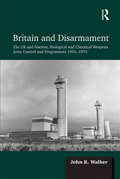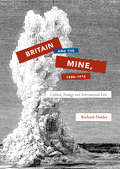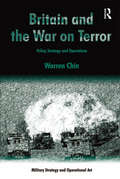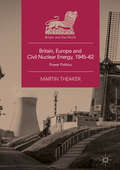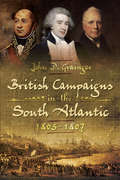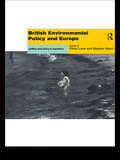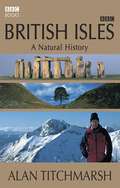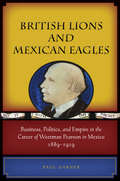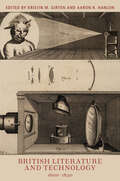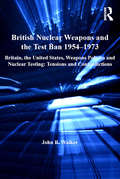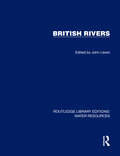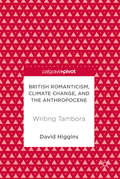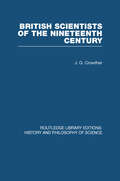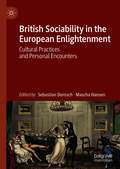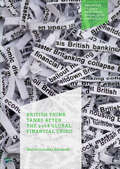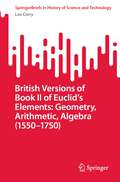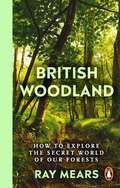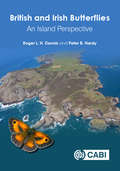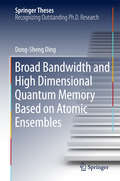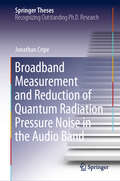- Table View
- List View
Britain and Disarmament: The UK and Nuclear, Biological and Chemical Weapons Arms Control and Programmes 1956-1975
by John R. WalkerSince the use of poison gas during the First World War and the dropping of atomic bombs on Japan at the end of the Second World War, nuclear, biological or chemical (NBC) weapons have registered high on the fears of governments and individuals alike. Recognising both the particular horror of these weapons, and their potential for inflicting mass death and destruction, much effort has been expended in finding ways to eliminate such weapons on a multi-lateral level. Based on extensive official archives, this book looks at how successive British governments approached the subject of control and disarmament between 1956 and 1975. This period reflects the UK's landmark decision in 1956 to abandon its offensive chemical weapons programme (a decision that was reversed in 1963, but never fully implemented), and ends with the internal travails over the possible use of CR (tear gas) in Northern Ireland. Whilst the issue of nuclear arms control has been much debated, the integration of biological and chemical weapons into the wider disarmament picture is much less well understood, there being no clear statement by the UK authorities for much of the period under review in this book as to whether the country even possessed such weapons or had an active research and development programme. Through a thorough exploration of government records the book addresses fundamental questions relating to the history of NBC weapons programmes, including the military, economic and political pressures that influenced policy; the degree to which the UK was a reluctant or enthusiastic player on the international arms control stage; and the effect of international agreements on Britain's weapons programmes. In exploring these issues, the study provides the first attempt to assess UK NBC arms control policy and practice during the Cold War.
Britain and the Mine, 1900–1915: Culture, Strategy And International Law
by Richard DunleyThis book examines Britain’s complex relationship with the mine in the years 1900-1915. The development of mine warfare represented a unique mix of challenges and opportunities for Britain in the years before the First World War. The mine represented the antithesis of British maritime culture in material form, and attempts were made to limit its use under international law. At the same time, mine warfare offered the Royal Navy a solution to its most difficult strategic problem. Richard Dunley explores the contested position occupied by the mine in the attitudes of British policy makers, and in doing so sheds new light on the overlapping worlds of culture, strategy and international law.
Britain and the War on Terror: Policy, Strategy and Operations (Military Strategy and Operational Art)
by Warren ChinWhy did Britain come to play such a prominent role in the war on terror and why did the military instrument come to be the dominant theme in the British prosecution of what was an ideological and political struggle? This book is an analysis of Britain’s war against Al Qaeda and the phenomenon of international terrorism which marked a paradigm shift in the nature and conduct of war in the twenty-first century. At the heart of the book is an attempt to understand why Britain, which possessed a wealth of experience in the conduct of counterterrorism, counterinsurgency and small wars, developed a strategic and operational design to defeat the Islamist threat which proved to be deeply flawed. In addressing this question the book explores the complex intellectual, doctrinal and geopolitical challenge posed by Al Qaeda and international terrorism and how and why the British response took the form that it did. In conducting this analysis the book raises important questions about the assumptions and perceptions of those in government who led the UK into this conflict, the nature of the civil military relationship in Britain and how well it functioned, and finally the competence of its security forces in being able to deal with this threat both domestically and overseas.
Britain, Europe and Civil Nuclear Energy, 1945–62: Power Politics (Britain and the World)
by Martin TheakerThis book examines the role played by civil nuclear energy in Britain’s relationship with Europe between the end of the Second World War and London’s first application to join the European Communities. Tracing the development of the British nuclear programme as it emerged as a global leader in constructing the world’s first atomic power stations, it analyses how the threat of energy shortages throughout the 1950s presented ministers with a golden opportunity to utilise nuclear cooperation as an instrument to influence the political shape of Europe. Importantly, this book will show how this chance was missed by ministers due to a combination of disorganization and diplomatic pressure, as well as a perennial lack of domestic resources. In so doing, this book joins the long-disconnected historiographies of European integration and nuclear energy to offer a new perspective on both scholarly fields.
British Campaigns in the South Atlantic, 1805–1807
by John D. GraingerBetween 1805 and 1807 the British mounted several expeditions into the South Atlantic aimed at weakening Napoleon's Spanish and Dutch allies. The targets were the Dutch colony on South Africa's Cape of Good Hope, which potentially threatened British shipping routes to India, and the Spanish colonies in the Rio de la Plata basin (now parts of Argentina and Uruguay). In 1805 an army of around 6,000 men was dispatched for the Cape under the highly-respected General David Baird. They were escorted and assisted by a naval squadron under Home Riggs Popham. The Cape surrendered in January 1806. Popham then persuaded Baird to lend him troops for an attack on Buenos Aires. Buenos Aires was taken in July but the paltry British force (around 2,400 men) was then besieged and forced to surrender in August. Popham was later court martialled for exceeding his orders.In Feb 1807 Montevideo was taken by a new (officially sanctioned) British force of 6,000 men. Whitelocke, the British Commander then attempted to retake Buenos Aires (not least to free British prisoners from the first attempt) but was defeated by unexpectedly fierce resistance stiffened by armed creoles and slaves. After heavy losses he signed an armistice, surrendering Montevideo and withdrawing all his forces. He too was court-martialled. One of the major themes of this new account is the strong Scottish connection Baird and Popham were both Scots, and the 71st Highlanders made up the main force in the Cape and Popham's adventure. Another is the unlooked for consequences of these actions. The arrival of Scottish Calvinist ministers in the Cape influenced the eventual development of apartheid, while successful resistance to the British, with little help from Spain, shaped and accelerated the independence movement in South America.
British Environmental Policy and Europe: Politics and Policy in Transition (Global Environmental Change Ser.)
by Stephen Ward Philip LoweThis book explores the effectiveness of the response of environmental groups and organisations in Britain in to the challenges of European integration. Examining the relative European orientation of British environmental policy, and the impact of British concerns on European environmental policy, the book examines issues of environmental diplomacy, institutional dynamics, and policy debates relating to specific concerns such as: * pollution * land use * transport * natural conservation Presenting a wealth of examples throughout, the book draws together contributions from leading academics and practitioners from institutions and organisations such as the DOE, European Commission, WWF and CPRE.
British Isles: A Natural History
by Alan TitchmarshAccompanying a major new BBC1 series presented by Alan Titchmarsh, British Isles: A Natural History is a fascinating journey through the natural history of Britain from its birth to the present day. Written in Alans uniquely readable style, the book chronicles the different periods in Britain's evolution, exploring everything from the geology and geography to the flora and fauna that make up the diverse landscapes of the British Isles. It also includes a gazetteer section detailing where you can explore for yourself Britain's natural treasures. Beautifully illustrated with 180 colour photographs, it will appeal to natural history enthusiasts and everyone who cares about the country they live in. The book contains the latest research gathered in the making of this new landmark series from the BBC's NHU in Bristol. Alan Titchmarsh is a bestselling BBC author and has sold over a million copies of his books which include How To Be A Gardener 1 and 2 and Royal Gardeners.
British Lions and Mexican Eagles: Business, Politics, and Empire in the Career of Weetman Pearson in Mexico, 1889-1919
by Paul GarnerBetween 1889 and 1919, Weetman Pearson became one of the world's most important engineering contractors, a pioneer in the international oil industry, and one of Britain's wealthiest men. At the center of his global business empire were his interests in Mexico. While Pearson's extraordinary success in Mexico took place within the context of unprecedented levels of British trade with and investment in Latin America, Garner argues that Pearson should be understood less as an agent of British imperialism than as an agent of Porfirian state building and modernization. Pearson was able to secure contracts for some of nineteenth-century Mexico's most important public works projects in large part because of his reliability, his empathy with the developmentalist project of Mexican President Porfirio Díaz, and his assiduous cultivation of a clientelist network within the Mexican political elite. His success thus provides an opportunity to reappraise the role played by overseas interests in the national development of Mexico.
British Literature and Technology, 1600-1830 (Aperçus: Histories Texts Cultures)
by Aaron R. Hanlon Joseph Drury Kristin M. Girten Laura Francis Erik L. Johnson Thomas A. Oldham Zachary M. Mann Kevin MacDonnell Emily M. West Deven M. Parker Jamison KantorEnlightenment-era writers had not yet come to take technology for granted, but nonetheless were—as we are today—both attracted to and repelled by its potential. This volume registers the deep history of such ambivalence, examining technology’s influence on Enlightenment British literature, as well as the impact of literature on conceptions of, attitudes toward, and implementations of technology. Offering a counterbalance to the abundance of studies on literature and science in seventeenth- and eighteenth-century Britain, this volume’s focus encompasses approaches to literary history that help us understand technologies like the steam engine and the telegraph along with representations of technology in literature such as the “political machine.” Contributors ultimately show how literature across genres provided important sites for Enlightenment readers to recognize themselves as “chimeras”—“hybrids of machine and organism”—and to explore the modern self as “a creature of social reality as well as a creature of fiction.”
British Nuclear Weapons and the Test Ban 1954-1973: Britain, the United States, Weapons Policies and Nuclear Testing: Tensions and Contradictions
by John R. WalkerIn 1962 Dean Acheson famously described Britain as having lost an Empire but not yet found a role. Perhaps nowhere is this more apparent than in the realms of nuclear weapons. An increasingly marginal world power, successive post-war British governments felt that an independent nuclear deterrent was essential if the country was to remain at the top table of world diplomacy. Focusing on a key twenty-year period, this study explores Britain's role in efforts to bring about a nuclear test ban treaty between 1954 and 1973. Taking a broadly chronological approach, it examines the nature of defence planning, the scientific goals that nuclear tests were designed to secure, Anglo-American relationships, the efficacy of British diplomacy and its contribution to arms control and disarmament. A key theme of the study is to show how the UK managed to balance the conflicting pressures created by its determination to remain a credible nuclear power whilst wanting to pursue disarmament objectives, and how these pressures shifted over the period in question. Based on a wealth of primary sources this book opens up the largely ignored subject of the impact of arms control on the UK nuclear weapons programme. Its appraisal of the relationship between the requirements and developments of the UK nuclear weapons programme against international and domestic pressures for a test ban treaty will be of interest to anyone studying post-war British defence and foreign policy, history of science, arms control, disarmament and non-proliferation and international relations. It also provides important background information on current events involving nuclear proliferation and disarmament.
British Plant Communities
by C. D. Pigott D. A. Ratcliffe D. W. Shimwell J. P. Huntley E. Radford M. J. Wigginton P. Wilkins A. J. C. Malloch H. J. B. Birks M. C. F. ProctorBritish Plant Communities is the first systematic and comprehensive account of all natural, semi-natural and major artificial habitats in Great Britain (excluding Northern Ireland), representing fifteen years of research by leading plant ecologists. The book breaks new ground in wedding the rigorous interest in the classification of plant communities that has characterized Continental phytosociology with the deep traditional concern in Great Britain to understand how vegetation works. The acclaimed series has become firmly established as a framework for a wide variety of teaching, research and management activities in ecology, conservation, and land-use planning.
British Plant Communities
by J. S. Rodwell C. D. Pigott D. A. Ratcliffe A.J.C.Malloch H.J.B.Birks M.C.F.Proctor D. W. Shimwell J. P. Huntley E. Radford M. J. Wigginton P. WilkinsBritish Plant Communities is the first systematic and comprehensive account of natural vegetation types of Great Britain. It covers all natural, semi-natural and major artificial habitats in Great Britain (excluding Northern Ireland), representing the fruits of fifteen years research by leading plant ecologists. Over 250 plant communities are described in the five volumes, with summaries of their vascular plants, bryophytes and lichens. There are full details in the text of the composition and structure of the vegetation, its relationships to habitat factors and its occurence in characteristic spatial patterns and successions. Numerous maps show the distribution of the communities through Britain and all the vegetation types are related to their closest equivalents in mainland Europe. For each major group of communities an introduction outlines the range of floristic variation and relates it to important environmental influences. A key provides the reader with a means of identifying vegetation types encountered in the field. There are indices to the communities and to their existing synonyms, and to all the plant species encountered in the survey. An extensive bibliography gives full details of the numerous literature references cited. British Plant Communities breaks new ground in wedding traditional Continental phytosociology with the deep concern in Britain to understand how vegetation works. It is intended as a working tool, offering a reliable framework for a wide variety of teaching, research, and management activities in ecology, conservation, and land use planning.
British Plant Communities 3
by J. S. RodwellBritish Plant Communities is the first systematic and comprehensive account of the vegetation types of Britain. It covers all natural, semi-natural and major artificial habitats in Great Britain (but not Northern Ireland), representing the fruits of fifteen years of research by leading plant ecologists. The book breaks new ground in wedding the rigorous interest in the classification of plant communities that has characterized Continental phytosociology with the deep concern traditional in Great Britain to understand how vegetation works. The published volumes have been greeted with universal acclaim, and the series has become firmly established as a framework for a wide variety of teaching, research and management activities in ecology, conservation and land-use planning.
British Rivers (Routledge Library Editions: Water Resources)
by John LewinOriginally published in 1981, this book describes and interprets the physical nature of British rivers and is authored by leading authors from universities, the Institute of Hydrology and a water Authority. The contents include data on river regimes and catchment characteristics, information on water quality in both polluted and unpolluted rivers, a full discussion of river channels and their erosion and sediment characteristics, and a consideration of river management problems in the distinctive British context. Where possible, nationwide information is presented in map form and many of the maps presented a national picture for the first time. The book will be of interest to students and scientists in a wide range of disciplines: geography, geology, environmental science, hydrology and engineering. Those professionally engaged in environmental management and the water industry should also find it useful. In summary, all who are concerned with rivers – as agents of landscape change, sedimenting phenomena, environmental resources or flood hazards will find this book as relevant now as when it was first published.
British Romanticism, Climate Change, and the Anthropocene: Writing Tambora
by David HigginsThis book is the first major ecocritical study of the relationship between British Romanticism and climate change. It analyses a wide range of texts - by authors including Lord Byron, William Cobbett, Sir Stamford Raffles, Mary Shelley, and Percy Shelley - in relation to the global crisis produced by the eruption of Mount Tambora in 1815. By connecting these texts to current debates in the environmental humanities, it reveals the value of a historicized approach to the Anthropocene. British Romanticism, Climate Change, and the Anthropocene examines how Romantic texts affirm the human capacity to shape and make sense of a world with which we are profoundly entangled and at the same time represent our humiliation by powerful elemental forces that we do not fully comprehend. It will appeal not only to scholars of British Romanticism, but to anyone interested in the relationship between culture and climate change.
British Scientists of the Nineteenth Century
by J G CrowtherJ G Crowther has chosen five of the greatest scientists of the nineteenth century – Davy, Faraday, Clerk-Maxwell, Joule, Lord Kelvin and examines every aspect of their lives and work.
British Scientists of the Twentieth Century (Routledge Library Editions: History & Philosophy of Science)
by J G CrowtherFollowing on from British Scientists of the Nineteenth Century, this volume covers six eminent British scientists whose work and personality have not receded into the same depth of perspective as their predecessors of the Nineteenth Century, but the tremendous changes following the two world wars have already cut them off sharply from this generation.
British Sociability in the European Enlightenment: Cultural Practices and Personal Encounters
by Sebastian Domsch Mascha HansenThis volume covers a broad range of everyday private and public, touristic, commercial and fictional encounters between Britons and continental Europeans, in a variety of situations and places: moments that led to a meaningful exchange of opinions, practices, or concepts such as friendship or politeness. It argues that, taken together, travel accounts, commercial advice, letters, novels and philosophical works of the long eighteenth century, reveal the growing impact of British sociability on the sociable practices on the continent, and correspondingly, the convivial turn of the Enlightenment. In particular, the essays collected here discuss the ways and means – in conversations, through travel guides or literary works – by which readers and writers grappled with their cultural differences in the field of sociability. The first part deals with travellers, the second section with the spreading of various cultural practices, and the third with fictional encounters in philosophical dialogues and novels.
British Think Tanks After the 2008 Global Financial Crisis (Palgrave Studies in Science, Knowledge and Policy)
by Marcos González HernandoThis book examines the intellectual and institutional transformations of four British think tanks in the aftermath of the 2008 global financial crisis. In the context of a crisis of expert authority, González Hernando demonstrates how these organisations modified their mode of public engagement to be seen as authoritative as possible by an ever more mistrustful public. British Think Tanks After the 2008 Global Financial Crisis connects sociological thinking on knowledge with research on policy change and the economic debate, through careful analysis of interviews, public accounts, and the ‘products’ of think tanks themselves. González Hernando argues that demands for knowledge and advice that arose after the crisis energised the work of all four think tanks while also exposing internal tensions, affecting their sources of funding, transforming their institutional structure, and shaping how they engage with their audiences. It will appeal to students and scholars of sociology of knowledge, political sociology, policy studies, economic history, communication, political economy, organisational sociology, and British politics
British Versions of Book II of Euclid’s Elements: Geometry, Arithmetic, Algebra (SpringerBriefs in History of Science and Technology)
by Leo CorryThis book discusses the changing conceptions about the relationship between geometry and arithmetic within the Euclidean tradition that developed in the British context of the sixteenth and seventeenth century. Its focus is on Book II of the Elements and the ways in which algebraic symbolism and methods, especially as recently introduced by François Viète and his followers, took center stage as mediators between the two realms, and thus offered new avenues to work out that relationship in idiosyncratic ways not found in earlier editions of the Euclidean text. Texts examined include Robert Recorde's Pathway to Knowledge (1551), Henry Billingsley’s first English translation of the Elements (1570), Clavis Mathematicae by William Oughtred and Artis Analyticae Praxis by Thomas Harriot (both published in 1631), Isaac Barrow’s versions of the Elements (1660), and John Wallis Treatise of Algebra (1685), and the English translations of Claude Dechales’ French Euclidean Elements (1685). This book offers a completely new perspective of the topic and analyzes mostly unexplored material. It will be of interest to historians of mathematics, mathematicians with an interest in history and historians of renaissance science in general.
British Woodland: How to explore the secret world of our forests
by Ray MearsNobody sees and understands woodland better than Ray Mears.With deep natural history knowledge and practical woodcraft skills, gained over a lifetime of learning from the world's last remaining indigenous peoples, Ray offers a different way to experience our wooded landscapes. He challenges the old concepts. He looks to our ancestors and shows how man's hand in shaping woodland is critical. We are not separate from nature, we just need to ensure that our interactions have a positive impact.With the emphasis on interaction, British Woodland is structured by usage. We learn that sycamore and clematis are among the best woods for burning, pine and oak help us navigate, and hawthorn and beech have edible leaves. Rope can be made from willow, utensils and tools from hazel, and historically, weapons were made from yew and wych elm.With Ray as our guide, encouraging this sense of connection to individual trees, our appreciation of wooded landscapes will change. We can learn how to live inclusively in nature, for our own wellbeing and enjoyment, and also for the future of our planet.
British and Irish Butterflies: An Island Perspective
by Roger L Dennis Peter B HardyIslands are special places; they can be havens for unique plants and animals and refuges for wildlife. This book investigates the biogeography of butterfly species over the British islands, particularly the factors that influence their presence on the islands and that have made each island's butterfly fauna distinctive. The book contains a full log of records of species on the islands and much supporting information. The first three chapters set the scene, illustrating the basics of island biogeography theory, their changing circumstances during the current Holocene interglacial, and studies of natural history of British butterflies that mark the islands as the most intensively studied region for wildlife in the world. The book advances by increasing resolution downscale from a European continental perspective, through patterns and changes on the British mainland, a comparison of the two dominant islands of Britain and Ireland, to a close inspection of the dynamics of species on the multitude of offshore islands. Detailed investigations include contrasts in species' richness on the islands and then of the incidences of each species. Case studies highlight the continual turnover of species on islands. Attention is then given to evolutionary changes since the time that glaciers enveloped Europe. A powerful message is conveyed for the maintenance of butterfly species on the smaller British islands now experiencing population losses at a rate unprecedented since the spread of the last ice sheets: the incontrovertible importance of maintaining populations of species on nearby mainland sources for islands as pools for future migrants. This book is enhanced with supporting material. To access the Online Supplementary Appendices below, please visit: http://www.cabi.org/openresources/95061. Supplementary Appendices Chapter 3 3.1a A copy of Dennis and Shreeve (1996) Butterflies on British and Irish Offshore Islands: Ecology and Biogeography. Gem Publishing Company, Wallingford, Oxon 3.1b The main data file for British and Irish offshore islands 3.2 Basic ecological and life history data used to build the indices for migration capacity and colonization ability Supplementary Appendices Chapter 4 4.1 Contemporary Geography Study of British Butterflies: Data 4.2 Contemporary Geography Study of British Butterflies: Analyses Supplementary Appendices Chapter 5 5.1a The European Islands Data File: Recent Sources 5.1b The European Islands Data File: Butterfly Records 5.1c The European Islands Data File: Geographical Data 5.2 Comparison of British and Irish Species Distributions Supplementary Appendices Chapter 6 6.1a Species Incidences on Offshore Islands: Logit Regression Analyses 6.1b Species Incidences on Offshore Islands: Discriminant Function Analyses 6.2 Species Richness and Incidences on Offshore Islands: Predictions Supplementary Appendix Chapter 7 7.1 Records and Data for the Isle of Man
British and Irish Butterflies: An Island Perspective
by Roger L Dennis Peter B HardyIslands are special places; they can be havens for unique plants and animals and refuges for wildlife. This book investigates the biogeography of butterfly species over the British islands, particularly the factors that influence their presence on the islands and that have made each island's butterfly fauna distinctive. The book contains a full log of records of species on the islands and much supporting information. The first three chapters set the scene, illustrating the basics of island biogeography theory, their changing circumstances during the current Holocene interglacial, and studies of natural history of British butterflies that mark the islands as the most intensively studied region for wildlife in the world. The book advances by increasing resolution downscale from a European continental perspective, through patterns and changes on the British mainland, a comparison of the two dominant islands of Britain and Ireland, to a close inspection of the dynamics of species on the multitude of offshore islands. Detailed investigations include contrasts in species' richness on the islands and then of the incidences of each species. Case studies highlight the continual turnover of species on islands. Attention is then given to evolutionary changes since the time that glaciers enveloped Europe. A powerful message is conveyed for the maintenance of butterfly species on the smaller British islands now experiencing population losses at a rate unprecedented since the spread of the last ice sheets: the incontrovertible importance of maintaining populations of species on nearby mainland sources for islands as pools for future migrants. This book is enhanced with supporting material. To access the Online Supplementary Appendices below, please visit: http://www.cabi.org/openresources/95061. Supplementary Appendices Chapter 3 3.1a A copy of Dennis and Shreeve (1996) Butterflies on British and Irish Offshore Islands: Ecology and Biogeography. Gem Publishing Company, Wallingford, Oxon 3.1b The main data file for British and Irish offshore islands 3.2 Basic ecological and life history data used to build the indices for migration capacity and colonization ability Supplementary Appendices Chapter 4 4.1 Contemporary Geography Study of British Butterflies: Data 4.2 Contemporary Geography Study of British Butterflies: Analyses Supplementary Appendices Chapter 5 5.1a The European Islands Data File: Recent Sources 5.1b The European Islands Data File: Butterfly Records 5.1c The European Islands Data File: Geographical Data 5.2 Comparison of British and Irish Species Distributions Supplementary Appendices Chapter 6 6.1a Species Incidences on Offshore Islands: Logit Regression Analyses 6.1b Species Incidences on Offshore Islands: Discriminant Function Analyses 6.2 Species Richness and Incidences on Offshore Islands: Predictions Supplementary Appendix Chapter 7 7.1 Records and Data for the Isle of Man
Broad Bandwidth and High Dimensional Quantum Memory Based on Atomic Ensembles (Springer Theses)
by Dong-Sheng DingThis thesis presents an experimental study of quantum memory based on cold atomic ensembles and discusses photonic entanglement. It mainly focuses on experimental research on storing orbital angular momentum, and introduces readers to methods for storing a single photon carried by an image or an entanglement of spatial modes. The thesis also discusses the storage of photonic entanglement using the Raman scheme as a step toward implementing high-bandwidth quantum memory. The storage of photonic entanglement is central to achieving long-distance quantum communication based on quantum repeaters and scalable linear optical quantum computation. Addressing this key issue, the findings presented in the thesis are very promising with regard to future high-speed and high-capacity quantum communications.
Broadband Measurement and Reduction of Quantum Radiation Pressure Noise in the Audio Band (Springer Theses)
by Jonathan CripeThis book presents a direct measurement of quantum back action, or radiation pressure noise, on a macroscopic object at room temperature across a broad bandwidth in the audio range. This noise source was predicted to be a limitation for gravitational wave interferometers in the 1980s, but it has evaded direct characterization in the gravitational wave community due to the inherent difficult of reducing thermal fluctuations below the quantum back action level. This back action noise is a potential limitation in Advanced LIGO and Advanced Virgo, and Cripe’s experiment has provided a platform for the demonstration of quantum measurement techniques that will allow quantum radiation pressure noise to be reduced in these detectors. The experimental techniques Cripe developed for this purpose are also applicable to any continuous measurement operating near the quantum limit, and could lead to the possibility of observing non-classical behavior of macroscopic objects.
